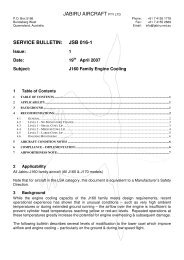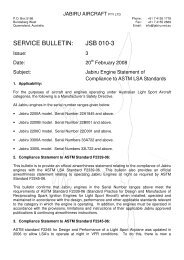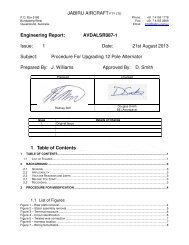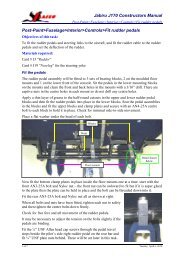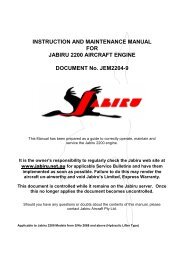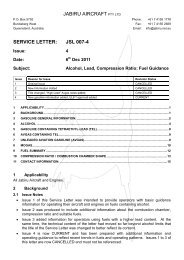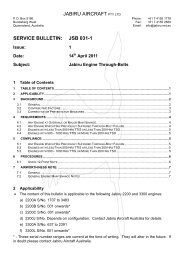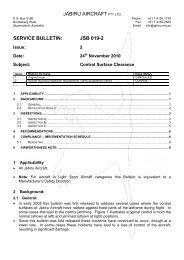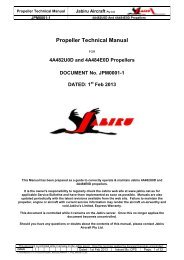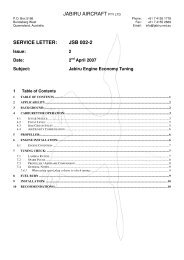INSTALLATION MANUAL FOR JABIRU 2200 AIRCRAFT ENGINE ...
INSTALLATION MANUAL FOR JABIRU 2200 AIRCRAFT ENGINE ...
INSTALLATION MANUAL FOR JABIRU 2200 AIRCRAFT ENGINE ...
Create successful ePaper yourself
Turn your PDF publications into a flip-book with our unique Google optimized e-Paper software.
<strong>INSTALLATION</strong> <strong>MANUAL</strong><strong>FOR</strong><strong>JABIRU</strong> <strong>2200</strong> <strong>AIRCRAFT</strong> <strong>ENGINE</strong>DOCUMENT No. JEM2202-5This Manual is a guide to correctly install the Jabiru <strong>2200</strong> engine into an airframe.If you have any questions or doubts about the contents, please contact Jabiru Aircraft P/L.Applicable to Jabiru <strong>2200</strong>cc Enginers, S/No. 2068 Onwards (Hydraulic Lifter Type)
1 Description1.1 ModelJabiru Aircraft Pty LtdInstallation ManualJabiru <strong>2200</strong> Aircraft EngineThis Manual applies to all Jabiru <strong>2200</strong> Engine Models, but particularly those from S/No 2068 on. Details foroperating and servicing are supplied in the Engine Instruction & Maintenance Manual.Only those details relevant for installation are duplicated below – for all other information please refer tothe Instruction & Maintenance Manual.1.2 ManualsInstruction and Maintenance ManualInstallation ManualParts Catalogue1.3 SpecificationsAll information given in this manual assumes static sea level ratings under the following conditions:-• International Standard Atmospheric conditions at sea level.• Aircraft service equipment drives unloaded. (Vacuum Pump not fitted)• Full rich fuel/air mixture.• Standard Jabiru air filter and hot air mixer box assembly.• Standard exhaust muffler.• Jabiru Propeller• Jabiru Airframe1.3.1 RatingsRPM – Maximum (Redline):..................................... 3300 RPMRPM – Maximum Continuous:................................. 3300 RPMRPM – Recommended Cruise:................................ 2750 RPM – 3100 RPMPower Rating: .......................................................... 85 hp / 3300 RPM1.3.2 FuelFuel Consumption:................................................... 21 L/hr @ Takeoff / Max Continuous RatingFuel Consumption:................................................... 13-15 L/hr @ 75% nominal power setting.Fuel Pressure to Carburettor Maximum .................. 20 kPa (3 psi)Fuel Pressure to Carburettor Minimum ................... 5 kPa (0.75 psi)Recommended Fuel Grade ..................................... Avgas 100LL & Avgas 100/130Note: Leaded and Unleaded Automotive Gasoline above 95 Octane RON may be used, however due to the lackof a strong quality control system for automotive fuels Jabiru Aircraft recommend using AVGAS whereverpossible.1.3.3 OilOil Capacity.............................................................. 2.3 LitresOil – Minimum Temperature for Take-Off................ 50°C (122°F)Oil – Maximum Peak Oil Temperature .................... 118°C (244°F)Oil – Maximum Continuous Oil Temperature .......... 80°C – 100°C (176°F - 212°F)Oil Pressure – Normal Operations........................... Min 220 kPa (32 psi)........................... Max 525 kPa (76 psi)REVISION 0 1 2 3 4 5 Dated : June 2008 Page: 5 of 57
Jabiru Aircraft Pty LtdInstallation ManualJabiru <strong>2200</strong> Aircraft EngineOil Pressure – Idle ................................................... Min 80 kPa (12 psi)Oil Pressure – Starting & Warm Up......................... Max 525 kPa (76 psi)Oil Consumption ...................................................... 0.1 L/hr (max)Oil Standard............................................................. Aero Oil W Multigrade 15W-50, or equivalent complying with............................................................ MIL-L-22851C, or............................................................ Lycoming Spec. 301F, or............................................................ Teledyne - Continental Spec MHF-24B1.3.4 AdditivesNote: No Oil or fuel additives should be used. Use of oil or fuel additives will void warranty.1.3.5 Cylinder Head Temperature (CHT)Maximum Peak Cylinder Head Temperature 1 ......... 200ºC (392°F)Maximum Continuous Temperature ........................ 180ºC (356°F)Note: Time with CHT at between 180°C and 200°C is not to exceed 5 Minutes1.3.6 Exhaust Gas Temperature (EGT)EGT (Mid-Range / Cruise): ...................................... Min 680° - 720°C (1256° - 1328°F)EGT (Above 70% Power): ....................................... Min 640° - 680°C (1184° - 1256°F)Note: An EGT gauge is not included as standard equipment on the Jabiru <strong>2200</strong> engine, though a system can besupplied as an option.1.3.7 Ground Running LimitationsGround Idle Speed................................................... 900 RPM (set while engine is hot)Ground Oil Pressure – Idle / Startup........................ Min 80 kPa (11 psi)........................ Max 525 kPa (76 psi)Ground Oil Temperature.......................................... Max. 100°C (212°F)Ground Maximum Cylinder Head Temperature....... 180°C (356°F)Note: If ground temperature limits are reached, shut the engine down or cool it by pointing the aircraft into wind.1 Measured with sensor ring fitted under exhaust spark plug.REVISION 0 1 2 3 4 5 Dated : June 2008 Page: 6 of 57
Jabiru Aircraft Pty Ltd1.4 DimensionsInstallation ManualJabiru <strong>2200</strong> Aircraft EngineFigure 1. Drawing 9404041/1 Engine DimensionsFigure 2. Drawing W000505 – Engine Dimensions S/No. 2553 OnREVISION 0 1 2 3 4 5 Dated : June 2008 Page: 7 of 57
Jabiru Aircraft Pty LtdInstallation ManualJabiru <strong>2200</strong> Aircraft Engine1.4.1 Denomination Of CylindersCylinder Firing Order: 1 – 3 – 2 – 4Figure 3. Cylinder Firing OrderFigure 4. Distributor Cylinder MapREVISION 0 1 2 3 4 5 Dated : June 2008 Page: 8 of 57
Jabiru Aircraft Pty LtdInstallation Manual2 Engine MountThe design of the engine mount must balance many requirements:Jabiru <strong>2200</strong> Aircraft Engine• The mount must be strong enough to carry the loads applied by the weight and power of the engine.• The mount must be stiff enough that the engine does not sag or move too much when power is applied.• The mount must position the engine at the correct height and angle so that the engine’s thrust line suits theaircraft. In most installations, Jabiru Engines need to have their thrust axis offset to the right (tractorinstallations) by between 1° and 2°.• The mount must position the engine at the right place. The weight of the engine is a very significant part ofthe overall aircraft weight, and it’s position must be calculated to place the centre of gravity of the aircraft(CG) in the right spot.• The mount must be designed to allow enough room for the air intake to the Carburettor as well asaccessories like vacuum pumps. Access for maintenance must also be considered.• The final design of the engine mount is a compromise, and sometimes special parts will be required to makeit work. Figure 7 shows the installation of a Jabiru 8-cylinder engine into a Van’s RV-6. To give a good CGlocation the engine had to be mounted as close to the firewall as possible. This meant that custom air intaketubes had to be developed to get the intake air to the carburettor with a minimum disturbance andturbulence.The engine has four engine mounting points located at the rear of the engine (shown in Figure 1 or Figure 2)from which the engine is to be mounted. An optional bed mount may be fitted.Figure 5. Engine Mount Point Locations• Each engine mounting point is rubber mounted to damp the engine vibrations. The correct installation ofthese rubbers is shown below in Figure 5.• If required, corrections of the engine angle or propeller position can be made by fitting spacers under therubber cushions. The maximum spacer thickness on any one mount is 3mm.REVISION 0 1 2 3 4 5 Dated : June 2008 Page: 9 of 57
Jabiru Aircraft Pty LtdInstallation ManualJabiru <strong>2200</strong> Aircraft EngineCustom air intake tube (“Cobra Head”)Figures 6 & 7. Typical Upper Engine Mount, Air Intake InstallationFigure 8 Engine Mount AssemblyREVISION 0 1 2 3 4 5 Dated : June 2008 Page: 10 of 57
Jabiru Aircraft Pty LtdInstallation Manual3 ControlsThis section comprises of the mechanical controls and electrical switches.3.1 Throttle and ChokeJabiru <strong>2200</strong> Aircraft Engine• The throttle and choke cables both attach to the cable mount arm fitted to the carburettor.• Note: Since a pressure compensating carburettor is used there is no mixture control.• The cables for the choke and throttle can be adjusted using the adjuster screws and nuts shown in Figure 9.A 7mm spanner is required.• The cables used must have an adequate radius wherever they turn a corner. Bending the cables too sharplywill increase the cable friction, making it difficult to use the control accurately. This is a particular problemfor the throttle cable as it will make setting the idle accurately very difficult.• All Jabiru engines are run-in on a Dynamometer before delivery. It is impossible to accurately set the idleRPM when the engine is on the dynamometer, so the Idle Stop Screw (shown in Figure 9) must be adjustedas a part of the engine installation process.Idle stop screwThrottle Cable connectedto throttle armCable mount bracketChoke Cable connectedto throttle armAdjustors to fine tune chokeand throttle operation3.2 Ignition & Starter SystemsFigure 9. Choke and Throttle Connections to Carburettor• The only electrical controls for the Jabiru Engine are the ignition switching and the start button.• The ignition switches and starter system wiring are connected as shown by the circuit diagram, Figure 29.• Section 5 gives details of the electrical systems for the engine.REVISION 0 1 2 3 4 5 Dated : June 2008 Page: 11 of 57
Jabiru Aircraft Pty LtdInstallation ManualJabiru <strong>2200</strong> Aircraft Engine4 Engine Crankcase Breather, Catch Bottle & Dipstick• The Jabiru <strong>2200</strong> engine has a crankcase breather connection built into the dipstick housing. This is to beconnected as shown in Figure 10 below.• The catch bottle is designed to catch most oil vapour from the crankcase breather air. It must be monitoredin service and periodically emptied of waste oil.• Figure 58 shows more clearly the outlet from the catch bottle – the catch bottle outlet is secured in the cowloutlet. The position of this outlet and the catch bottle itself must be assessed and oriented so that thecrankcase of the engine is exposed to pressure close to ambient. If the breather is open to a high or lowpressure (partial vacuum) area the pressure inside the crankcases will also change, with unpredictableeffects on engine oil consumption, and oil flow within the engine. This is because several areas of theengine are lubricated via low pressure or spray oil feeds, and drained by gravity – pressure differencescause airflow changes, and modified airflow can significantly affect the oil feeds in these areas.• Over the course of it’s development the <strong>2200</strong> engine has used several different sumps and dipstick lengths.Figure 11 gives an explanation of these lengths and what oil levels should be maintained.• When installed in a tail-dragger aircraft, re-calibration of the dipstick will be required by the owner so that itcan be read accurately with the aircraft sitting on it’s wheels.Hose from engineCatch bottleattached to firewallHose from engineto catch bottleHose to outletFigure 10. Crankcase Breather InstallationREVISION 0 1 2 3 4 5 Dated : June 2008 Page: 12 of 57
Jabiru Aircraft Pty LtdInstallation ManualJabiru <strong>2200</strong> Aircraft EngineFigure 11. Dipstick Family TreeREVISION 0 1 2 3 4 5 Dated : June 2008 Page: 13 of 57
Jabiru Aircraft Pty LtdInstallation Manual5 Electrical Equipment5.1 AlternatorJabiru <strong>2200</strong> Aircraft Engine• The alternator fitted to the Jabiru <strong>2200</strong> engine is a single phase, permanently excited with a regulator.• The rotor is mounted on the flywheel and the stator is mounted on the alternator mount plate at the back ofthe engine. The alternator mount plate is also the mount for the ignition coils and the vacuum pump.• Note: The electrical system is Negative EarthSpecificationsPower (Max): 120W Continuous (Up to Engine S/No. 2661)Power (Max): 200W Continuous (Engine S/No. 2662 onwards)Wire to ignition switchIgnition coil (1 of 2)Alternator rotor –mounted on flywheelAlternator stator –mounted on alternatormount plate fixed to rearof engine.Ignition magnets –mounted on flywheelFigure 12. Ignition & Alternator Detail5.2 Regulator• The regulator has been selected to match the voltage and current of the integral alternator. Only Jabiru PartNo. PI10652N should be used. (The regulator output voltage is 14 volts + 0.8 volt.).• Recommended wiring of regulator is positive and negative of the regulator directly to the battery. A 20A fuseor circuit breaker may be used between the regulator & battery• The regulator is equipped to illuminate a Low Voltage Warning Light. Refer to Figure 14 for plug pin details.REVISION 0 1 2 3 4 5 Dated : June 2008 Page: 14 of 57
Jabiru Aircraft Pty LtdInstallation ManualJabiru <strong>2200</strong> Aircraft EngineFirewallStarter SolenoidPower / Earth cables to starter motorRegulator PlugRegulator (Grey, finned block)Figure 13. Electrics Installation to Firewall5.3 IgnitionFigure 14. Regulator Plug Wiring Details• The ignition unit has dual breakerless transistorised ignition with the magnets mounted on the flywheel andthe coils mounted on the alternator mount plate. Figure 12 shows the coils of a Jabiru 6-cylinder engine.For the <strong>2200</strong> engine the system is the same, however the position of the coils and the magnets on theflywheel are slightly different.• The current from the coils flows to the distributor from where it is distributed to the spark plugs.REVISION 0 1 2 3 4 5 Dated : June 2008 Page: 15 of 57
Jabiru Aircraft Pty LtdInstallation ManualJabiru <strong>2200</strong> Aircraft Engine• The ignition is turned OFF by grounding the coils via the ignition switches. This is the reverse of mostelectrical systems: when the ignition switch is in the open (not connected) position the coil is LIVE and willfire. Wiring details are shown in Figure 28.• The ignition is timed to 25° BTDC. Ignition timing is fixed – it is set by the position of the flywheel magnetsrelative to the crankshaft.• The temperature limit for the ignition coils is approximately 70°C. This should be checked by the installer. Itis recommended that pipes of 12mm dia be fitted to the top rear of each air duct directing air onto the coilsfor cooling purposes.• Coil gaps are set at 0.25mm to 0.30mm (0.010” to 0.012”).• When installing new ignition coils the output leads go in the directon of prop rotation. RHS coil output leadis up LHS coil output lead goes down – See Figure 12.Ram air cooling ductCoil cooling tubeIgnition coil5.4 Starter MotorFigure 15. Ignition Coil Cooling Tube• The starter is mounted on the top of the engine and drives the ring gear on the flywheel.• The motor is activated by engaging the starter button (the master switch has to be ON) which trips thesolenoid, hence current flows from the battery to the motor.• The cable from Battery to starter should be minimum 16mm 2 copper.• Wiring details are shown in Figure 28.5.5 Starter Solenoid• The starter Solenoid is mounted on the firewall as shown in Figure 13.• The Solenoid body forms a part of the electrical circuit and MUST be earthed to function correctly.REVISION 0 1 2 3 4 5 Dated : June 2008 Page: 16 of 57
Jabiru Aircraft Pty LtdInstallation ManualJabiru <strong>2200</strong> Aircraft Engine5.6 BatteryFigure 16. Starter Wiring Details• The battery should be of a light weight, 12V, 20 Ah type able to accept a charging voltage up to 14 V (+0.8V) and a 30 AMP Input.• For optimum starting the battery used must have a high Cranking Amp Capacity (also known as Pulse AmpCapacity). The standard battery used by Jabiru Aircraft has a Pulse Amp rating of 625 Amps. Batteries withhigher Pulse Amp ratings may be used and will improve engine starting in colder climates.5.7 Wiring Practices• Using aircraft grade wiring is strongly recommended. Compared to other grades of wire aircraft grade cancarry higher currents for the same physical size and weight. The insulation used on aircraft grade wire isalso frame resistant and is designed for better resistance to damage caused by chaffing or rubbing.• Care should be taken to identify each wire via labels or similar. This makes troubleshooting electrical issuesmuch easier.• Wherever possible wires should be identified as carrying “Power” or “Earth”. This can be done by usingdifferent colour connectors or applying rings of coloured heat-shrink during assembly. Again, this stepsimplifies troubleshooting or later modification.• Wires should be laid out in bundles and supported along their length to prevent failures due to fatigue.REVISION 0 1 2 3 4 5 Dated : June 2008 Page: 17 of 57
Jabiru Aircraft Pty LtdInstallation ManualJabiru <strong>2200</strong> Aircraft Engine5.8 Instruments5.8.1 Electronic Tachometer• General wiring information for the Tachometer is given in the Wiring Diagram, Figure 28. Detailedinstructions on it’s installation are supplied by the instrument manufacturer.• The tachometer picks up on 2 metal tabs attached to the inside of the flywheel.• The Pickup used is a Magnetic Induction sender type. It is a passive device requiring no external power.• They Pickup outputs a voltage in response to variations in their self-induced magnetic field caused byproximity to moving ferrous metal parts (such as the tags fitted to the rear of the flywheel).• The Tachometer sender must be adjusted to have approximately a 0.4mm gap between the tip of the senderand the tag. Note that due to normal bearing clearances the crankshaft moves slightly when the engine isrunning, so if this gap is set too small the sender will hit the tag. The sender is fragile and most timesdamage like this means that the sender must be replaced. If the gap is different for each of the two tagsthen one tag can be carefully bent to be the same as the other.• Ensure gauge is reading correctly. While large errors will be obvious, smaller errors are harder to pick and itis recommended to check the gauge reading with another instrument (such as a hand-held optical proptach).Tachometer SenderFigure 17. Tachometer Sender InstallationConnect to Red Wire oftachometer pick-upConnect to Black wire oftachometer pick-up8 7 6 54 3 2 1Figure 18. Tachometer ConnectionsConnect to Earth BusConnect to positive, such asthe Instrument Wiring BusREVISION 0 1 2 3 4 5 Dated : June 2008 Page: 18 of 57
Jabiru Aircraft Pty LtdInstallation ManualJabiru <strong>2200</strong> Aircraft Engine5.8.2 Oil Temperature Gauge• The Oil Temperature Gauge uses an electric probe mounted in the base of the sump. Jabiru Part No.PI10752N is recommended.• The gauge has 3 pins, one marked “+” – which is connected to power, one “S” – which is connected to thesensor and one un-marked – which is connected to earth.• The temperature sender is a brass fitting installed in the engine sump beside the drain plug.• The oil temperature relies on a good earth connection between the sensor, the engine and the airframeearth terminal. If there is excess resistance at any of these points gauge reading errors will occur.Oil Temperature sender withwire connectedEngine sump drain plugFigure 19. Oil Temperature Sender+ SFigure 20. Oil Temperature ConnectionsREVISION 0 1 2 3 4 5 Dated : June 2008 Page: 19 of 57
Jabiru Aircraft Pty LtdInstallation ManualJabiru <strong>2200</strong> Aircraft Engine5.8.3 Oil Pressure Gauge• An electric oil pressure sender is fitted to the engine for an Oil Pressure Gauge. Jabiru Part No. PI10762Nis the recommended gauge.• The gauge has 3 pins, one marked “+” – which is connected to power, one “S” – which is connected to thesensor and one un-marked – which is connected to earth.Oil filterOil Temperature sender withwire connectedFigure 21. Oil Pressure Sender+ SFigure 22. Oil Pressure Connections5.8.4 Voltage Gauge (Optional)• A voltage gauge can be connected to the aircraft systems.• The gauge has 2 pins, one marked “+” – which is connected to power and one un-marked – which isconnected to earth.+ SFigure 23. Voltage Gauge ConnectionsREVISION 0 1 2 3 4 5 Dated : June 2008 Page: 20 of 57
Jabiru Aircraft Pty LtdInstallation ManualJabiru <strong>2200</strong> Aircraft Engine5.8.5 Cylinder Head Temperature Gauge• The Cylinder Head Temperature Gauge uses a thermocouple which is installed to the exhaust spark plug ofthe hottest cylinder of the engine.• The head temperatures of air cooled engines are typically quite variable – differences of 50°C (90°F)between the hottest and coolest head are not uncommon. Refer to Section 13 for additional information oncooling.• For a new installation an audit must be done to establish which is the hottest cylinder. The CHTthermocouple probe is then fitted under the exhaust spark plug on that cylinder. Cylinder number 4 oftenruns hottest in normal tractor installations, however for new installations this MUST be checked andconfirmed. Jabiru Part No. PI10732N is the recommended gauge.• Care must be taken when installing the spark plug terminal – the terminal must be aligned with the sparkplug. If the terminal is not aligned the spark plug seal will be poor and hot combustion gasses can leak out.These very hot gases will cause the thermocouple to mis-read and show high CHT’s. Figure 25 showsproperly and improperly fitted CHT terminals.• Loom and Thermocouple sensor are supplied with the instrument. These must be installed as per theinstrument manufacturer’s directions. If cable is too long it must be looped as many times as necessary andstrapped behind the instrument panel.DO NOT CUT TO LENGTHThe Thermocouple sensor works by reading small voltages generated by the sensor wires, and cutting thewire upsets the instrument’s calibration.• Ensure that wire is not chaffing on the fibreglass air duct or cooing fins.• No power connection is required – the instrument reads directly off the voltage created by the thermocouplewire.• Temperature of the cold junction for best results should be around 50ºC. Ensure cold junction is mountedas far from the thermo couple probe as possible.Cold JunctionPlug terminal under spark plugCHT ThermocoupleCold Junction Spark Plug TerminalFigure 24. CHT Sender (Thermocouple) InstallationREVISION 0 1 2 3 4 5 Dated : June 2008 Page: 21 of 57
Jabiru Aircraft Pty LtdInstallation ManualJabiru <strong>2200</strong> Aircraft EngineFigure 25. CHT Terminal Installation+Figure 26. CHT Gauge Connections5.8.6 Exhaust Gas Temperature Gauge• An optional Exhaust Gas Temperature Gauge can be fitted. The probe should be positioned 100mm fromthe port flange on the exhaust pipe of a convenient cylinder. Jabiru Part No. PI0325N is the recommendedgauge.5.9 Radio Frequency (RF) Noise Reduction• RF noise is a common problem with aircraft. Symptoms include:i. Radio squelch setting needs to be highii. Excess noise in the background during transmissionsiii. Squeals or other feedback noises heard during transmissioniv. Intermittent static or noise breaking through the squelch.• RF noise is a complex problem and is influenced by many different factors. The following points do notcontain everything there is to know about RF noise, but they are given as recommendations of general goodpractice to minimise it’s effect.• Ensure all connections, particularly engine earths, are clean and un-corroded.• If the aircraft has a metallic firewall it can be used as a shield to block the majority of RF noise. To be mosteffective any wire that passes through the firewall should be fitted with a Ferrite Bead (also known as aSuppressor or RF Suppressor). Bundles of wires can have a single large Suppressor fitted rather than aREVISION 0 1 2 3 4 5 Dated : June 2008 Page: 22 of 57
Jabiru Aircraft Pty LtdInstallation ManualJabiru <strong>2200</strong> Aircraft EngineSuppressor for each wire. The wiring diagram in Figure 28 shows suppressors in schematic form. Thesesuppressors are readily available at local electronics stores.• A Noise Filter can be fitted to the radio’s power supply. Again, these filters are readily available from localelectronics stores. The manufacturer’s instructions must be followed for installation.• Cables passing through the firewall (such as throttle cables, choke, carburettor heat and cabin heat cables)can transmit RF noise back into the cabin. This can be minimised by earthing the cables at ONE end. Onthe Jabiru Engine an earth wire (Shown in Figure 29) is provided connecting the carburettor to the rest of theengine, so the throttle and choke cables are connected to earth through this wire.• It is normal & unavoidable that the engine’s ignition system produces some RF noise. This can beminimised by:i. Ensuring all spark plug gaps are set properly.ii. Ensure ignition coil gaps are set properlyiii. Ensure all high-tension leads (Spark plug leads) are firmly fitted at both ends – to the spark plug andto the distributor. In addition, the lead from each ignition coil to the distributor must be firmly fitted tothe distributor.iv. Ensure Distributor caps and rotors are in good condition.• To counteract RF noise, Jabiru Aircraft run shielded wiring on all radio and intercom wiring. In ourexperience, the “Earth Return” method of shielding (where the shield for the wire is also used to form theearth connection) does not work as well as the “Faraday Cage” (where the shield is a shield only – it is not apart of the circuit) method of shielding• “Earth Loops” – where a wire is connected to earth at both ends – can introduce RF noise into the system.All shields should be connected to the aircraft’s earth system at one end only.• The cable used for the Antenna should be high quality, such as RG400 (Shown in Figure 27). This cablehas a double layer of shielding and better RF insulation than other cable types. Note that the coaxial cableincluded in most antenna kits tends to have a single layer of insulation. BNC connectors are recommendedfor most applications, and wherever possible crimped connectors which require a special crimper toassemble should be used. Crimped connectors are much less prone to RF leakage or assembly issuesthan other types (such as screw-together BNC connectors).• Wires and antenna cables must be routed carefully. Bending or coiling Co-axial cable (such as is used forantennas) sharply will significantly degrade the cable’s RF shielding and must be avoided wherever possible.Coiling antenna cables or any wire carrying current (sensor wires carry very low current so are generallyexempt from this requirement) into loops can induce RF noise in other systems. GPS antennas in particularare powered – both the antenna and any excess antenna cable must be positioned carefully, as far awayfrom the radios, antennas and intercom as possible.• While not a part of the engine installation, strobes can produce significant RF noise. Most brands of strobesrequire that the box containing the strobe head unit electronics is earthed, and this is essential to minimisenoise. The cables used for the strobe lights themselves must be shielded and the shield must be earthedproperly, at ONE end only. The Box containing the strobe electronics can also be installed on the engineside of the firewall to further reduce RF noise. The strobe unit’s manufacturer normally provides goodinstructions for minimising their effect on radio noises.Black outer insulationOuter shield layerInner shield layerFigure 27. RG400 Co-Axial Antenna CableREVISION 0 1 2 3 4 5 Dated : June 2008 Page: 23 of 57
Jabiru Aircraft Pty LtdInstallation ManualJabiru <strong>2200</strong> Aircraft EngineFigure 28. Wiring DiagramREVISION 0 1 2 3 4 5 Dated : June 2008 Page: 24 of 57
Jabiru Aircraft Pty LtdInstallation ManualJabiru <strong>2200</strong> Aircraft EngineFigure 29. Wiring Diagram KeyREVISION 0 1 2 3 4 5 Dated : June 2008 Page: 25 of 57





